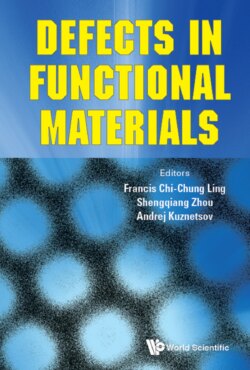Defects in Functional Materials

Реклама. ООО «ЛитРес», ИНН: 7719571260.
Оглавление
Группа авторов. Defects in Functional Materials
DEFECTS IN FUNCTIONAL MATERIALS
Preface
Contents
CHAPTER 1. Studying Properties of Defects
1. Introduction
2. Electrical Characterizations
3. Optical Characterization
4. Structural Characterization
5. Magnetic Characterization
6. Conclusions
References
CHAPTER 2. Defect Physics in 2D Nanomaterials Explored by STEM/STM
1. Introduction
2. Instrumentation and Technique
2.1. Principles of ADF-STEM and EELS in a TEM
2.2. Principles of STM and STS
3. Atomic Defects in 2D Transition Metal Dichalcogenides
3.1. Point defects in monolayer MoS2
3.1.1. Vacancies and antisite defects
3.1.2. Defect species vs sample synthesis methods
3.1.3. Local magnetism induced by antisite defects
3.2. Capturing the dynamics of point defects in MoS2
3.2.1. Mo adatom
3.2.2. Mo vacancy
3.3. Grain/domain boundaries in MBE-grown MoSe2
3.4. Stacking-band structure diversity in bilayer MoSe2
4. Summary
Acknowledgments
References
CHAPTER 3. Defects in Perovskites for Solar Cells and LEDs
1. Introduction to Perovskites
2. Defects in MAPbI3. 2.1. Theoretical calculations
2.2. Effects and properties of MAPbI3 defects
3. Defects in CsPbBr3. 3.1. Theoretical calculations
3.2. Effects and properties of CsPbBr3 defects
Acknowledgments
References
CHAPTER 4. Color Centers in Wide-Gap Semiconductors for Quantum Technology
1. Introduction
1.1. Diamond
1.2. SiC
2. Creation of Color Centers in Wide-Gap Semiconductors
2.1. Overview of creation method
2.2. MeV Focusing microbeam implantation
2.3. MeV proton beam writing
2.4. Position-controlled NV center by keV ion beams
2.5. Several hundreds of MeV ion irradiation
2.6. MeV electron irradiation
References
CHAPTER 5. Point Defects in InN
1. Introduction
2. Native Point Defects in InN
2.1. Tight-binding calculations
2.2. DFT-LDA calculations
2.3. Beyond-LDA results
3. Impurities in InN
3.1. Donors (O, Si, and H) 3.1.1. O in InN
3.1.2. Si in InN
3.1.3. Hydrogen in InN
3.2. Acceptors (Mg and C) 3.2.1. Mg in InN
3.2.2. C in InN
4. Defect Complexes
4.1. Vacancy complexes. 4.1.1. Nitrogen vacancy complexes
4.1.2. Indium vacancy complex
4.2. Complexes with vacancies. 4.2.1. Cation–anion vacancy pair
4.2.2. ON VIn complex and ON VIn
4.3. Other complexes
4.3.1. MgmOn complexes
4.3.2. SiiCj complexes
5. Summary
References
CHAPTER 6. Dopants and Impurity-Induced Defects in ZnO
1. Introduction
2. Point Defects in ZnO. 2.1. Intrinsic point defects
2.1.1. Oxygen vacancies
2.1.2. Zinc vacancies
2.1.3. Zinc interstitials
2.1.4. Oxygen interstitials
3. Impurities and Defect Complexes
3.1. Group I elements and hydrogen
3.2. Group-II element (Mg)
3.3. Group III elements
3.4. Group IV elements
3.5. Group V elements
4. Conclusions
Acknowledgments
References
CHAPTER 7. Ferromagnetism in B2-Ordered Alloys Induced via Lattice. Defects
1. Introduction
2. Antisite Disorder in B2 Fe60Al40
2.1. Experimental considerations for disordering using ions
2.2. Localized magnetic modifications using focused ion beams
2.3. Scaling-up irradiation-induced magnetic patterning
2.4. Open questions and current research on irradiation-induced antisite disorder
2.5. The role of open-volume defects in A2 → B2 re-ordering
3. Manipulation of Disorder using Laser Pulses
4. Disorder in B2 Fe50Rh50
5. Conclusions and Future Perspectives
Acknowledgments
References
CHAPTER 8. Defects-Induced Magnetism in SiC
1. Introduction
2. Experimental Evidence. 2.1. Material and defect inducing
2.2. Structural information
2.3. Defect characterization
2.4. Magnetic properties
2.5. The origin of magnetism
2.6. Transport property exploration
3. Theoretical Explanation
4. Outlook
5. Conclusions
References
CHAPTER 9. Ferromagnetism in ZnO-based Materials and Its Applications
1. Introduction
2. Exchange Interaction Models in DMS
2.1. Super exchange mechanism
2.2. Double exchange mechanism
2.3. RKKY interactions
2.4. Bound magnetic polaron
2.5. Density Functional Theory Study in TM:ZnO
3. Transitional Metal-Doped ZnO
3.1. Mn:ZnO system
3.2. Co:ZnO system
3.3. Cu:ZnO system
4. Anomalous Hall Effect in TM:ZnO System
4.1. Theory of AHE
4.2. AHE in TM:ZnO
5. Current Tools in Detecting True FM in TM:ZnO
5.1. Spinodal decomposition in TM:ZnO
5.2. Electric field control of FM
5.3. Ultrafast imaging tools for the future spintronic
6. Current Spintronics Device Concepts
6.1. Spin FET
6.2. Photo-induced ferromagnets
6.3. Spin LEDs
7. Summary and Viewpoint
Acknowledgments
References
Index
Отрывок из книги
Francis Chi-Chung Ling
University of Hong Kong, Hong Kong
.....
(4) The hyperfine interaction due to the nucleus of spin I associated with the defects leads each fine-structure line split into 2I + 1 hyperfine lines. Therefore, impurities with non-zero nuclear spin can be identified.
(5) The anisotropy of the spectra, e.g., the angular dependence of g as the crystal is rotated in the external field, gives information about the symmetry of the defects.
.....